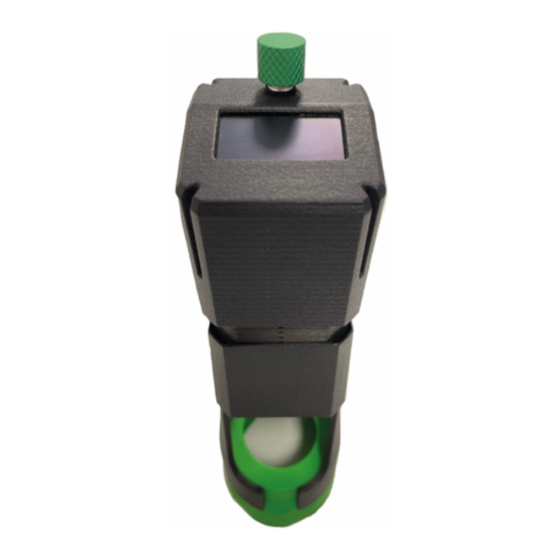
Summary of Contents for BPC instruments Move
- Page 1 OPERATION AND MAINTENANCE MANUAL BPC Move Agitation System Contact Us : www.bpcinstruments.com +46 (0)46 163950 Mobilvägen 10, 223 62 Lund, Sweden...
- Page 2 This document contains proprietary information protected by copyright. No part of this publication may be redistributed in any form whatsoever or translated into any language without prior, written permission of BPC Instruments AB. © 2022 BPC Instruments AB. All rights reserved.
-
Page 3: Table Of Contents
General Information…..……………………………………………………………………………………………… Quick Guide……………………………………………………………………………………………………………….. 7 Important Notes………………………………………………………………………………………………………… Chapter 01: Overview………………………………………………………………………………………………… Chapter 02: Description and Operation……………………………………………………………………. 2.1 BPC Move – Functionalities…………………………………………………………………… 2.1.1 Operation……………………………………………………………………………….. 2.1.2 Torque……………………………………………………………………………………. 2.1.3 Acceleration……………………………………………………………………………. 13 2.1.4 Advanced………………………………………………………………………………… 13 2.2 BPC Move – Features and Applications……………………………………………………. Chapter 03: Maintenance…………………………………………………………………………………………… 15... -
Page 4: General Information
Make sure to tie back any hanging objects, such as hair and clothing, when working near rotating or otherwise moving parts. Do not modify the instrument without the prior consent of the manufacturer. BPC Instruments AB do not assume responsibility for any errors due to equipment modification. - Page 5 The product warranty provided with the instrument corresponds to the stipulations in Orgaline 2012, unless otherwise agreed upon with BPC Instruments AB (“BPC”). BPC Instruments AB (“BPC”) reserves the right to correct any possible errors, mistakes, changes, updates, technical data or otherwise relevant information in this manual or any other documents, where applicable by law.
- Page 6 Optional Equipment The following equipment can be bought from BPC Instruments AB and its distributors. They are not required to perform experiments with the instrument, but they are fully compatible and, depending on the use case, can increase the effectiveness, abilities, or functions of the instrument.
-
Page 7: Quick Guide
Quick Guide... -
Page 9: Important Notes
IMPORTANT NOTES BPC Move can be applied to mix a diverse range of contents in bottles with different volumes, the only difference between them is the size of the stirrer, while all other components remain the same. When inserting the motor together with the metallic rod into the stirrer tube, make sure that the lid is properly sealed to ensure that the equipment does not risk being damaged. -
Page 10: Chapter 01: Overview
(clockwise [CW], counterclockwise [CCW] and interchanging), and on and off time. In order to function, BPC Move (A) needs to be connected to a stirrer (B) and a vessel (C) that contains the medium that will be mixed: A. -
Page 11: Chapter 02: Description And Operation
The BPC Move is connected to the stirrer through an axis coupling and this setup is placed at the top of the vessel. The stirrer contains a long axis rod inside a rubber, and a lid GL 45 with twin connectors. The bent stir rod can be fastened to the motor by attaching a helical coupling to it by using an Allen key to fasten the screws in the coupling. -
Page 12: Operation
Changes in speed can be done at any time during the mixing process with outstanding response time (BPC Move can go from 0 to 600 rpm in a few seconds). To change to another mode, the user needs to click the green... -
Page 13: Torque
The acceleration is a variable that measures the rate of change in velocity (speed) within a certain period of time. In the BPC Move, the acceleration function has the following range: 0 – 50. Since acceleration is directly proportional to the rate of change in velocity, higher values for this parameter will promote faster changes in speed. -
Page 14: Advanced
Shows the current installed firmware version on the instrument (X.Y.Z). 2.2 BPC Move – features and applications Here, we summarize the main features of BPC Move: ▪ Simplicity (BPC Move only needs a power supply to function) ▪ More agitation control and power ▪ Easy assembling and disassembling ▪... -
Page 15: Chapter 03: Maintenance
▪ Slow and regular agitation of sensitive biological samples CHAPTER 03: MAINTENANCE In order for the BPC® Move to perform properly and to maximise the lifespan of the instrument and its constituent parts, it is important to clean and maintain it properly. To clean the motor, wipe it with a damp cloth and, if required, a gentle form of detergent.


Need help?
Do you have a question about the Move and is the answer not in the manual?
Questions and answers